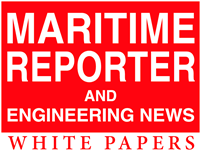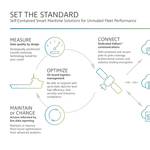
Traditional pipe-joining methods for shipbuilding are time-consuming and can pose significant safety concerns with the use of a torch or flame for welding and brazing pipe connections. Along with safety concerns, these methods present efficiency, labor and regulatory challenges. These challenges and concerns can be solved with the installation of mechanically attached fittings (MAFs), rather than pipe fittings that require welding or brazing. Advances in technology mean there are an array of fittings for installations and repairs for a variety of materials. These types of innovative fittings are versatile and can provide consistent connections without the need for fire watches or hot work permits. They promote substantial labor reduction with consistent first time quality and simplified testing/commissioning of systems.
MAFs, or mechanically attached fittings, are pipe-joining methods that use alternative methods to keep pipes together with the same performance as welded or brazed fittings. They come in different varieties depending on anchoring and sealing methods, i.e. press, bite, and slip on.
One of the recent innovations in MAF technology is the introduction of hybrid fittings, which combine features from bite-, press- and grip-type fittings. These fittings consist of a sleeve, grip ring, separator ring and sealing element. The grip ring with bidirectional teeth grips the outer surface of the pipe and locks the fitting to the pipe. The constant compression produces a positive, non-detachable mechanical joint.
There are three types of connections for mechanical joints that are established in the “ABS Rules for Building and Classing” for steel vessels: pipe unions, compression couplings and slip-on joints.
MAFs are approved by class societies like the American Bureau of Shipping (ABS) and accepted by the United States Coast Guard (USCG) for marine and offshore applications to be specified throughout a classed vessel including engine rooms and cat A machinery spaces. These approved shipboard applications include: potable water, compressed air, wet or dry fire main, fire sprinkler, fuel, lube oil, hydraulic oil and seawater cooling systems. However, 2018 rule changes do not allow MAFs in Class A Machinery Spaces or Accommodation Spaces (footnote 2 in the chart to the right) for flammable fluids (flash point >60 C) for fuel, lube oil, hydraulic oil and heating oil, reversing a series of long standing applications. Slip-on joints face a number of additional restrictions.
Below is the list of applications for the three types of mechanical joints, according to “ABS Steel Vessel Rules 2018.” The chart displays the kind of connection and how it relates to the eight major ship services, 33 listed ship applications and the service limitations imposed by the regulatory bodies based on systems and not joint capabilities.
Some MAF manufacturers build a leak detection feature into the fitting, rather than the sealing element, to ensure that there are no false positives. However, in a recent study, manufacturers that used a modified sealing element as a leak detection system on a ½" - 2″ path had false positives approximately 70% of the time. This means that under the initial system pressure testing, even if a joint had not been pressed, it will still hold pressure for a short amount of time, sometimes even hours or months. The other major issue with using a modified sealing element is that they do not use the three components (sealing element, separator and bite ring) in their 2-½"- 4″ sizes. Because of this, the tolerance is extremely tight on those sizes and many users have issues getting the pipe inserted into the fitting.
When the leak indicator is built into the fitting itself, this provides a repeatable and reliable indication of an unpressed joint 100 percent of the time. Upon pressing, the alloy is being squeezed closed or reformed into the fitting during the press, which removes the leak path without depending on the sealing element to do so.
Press fittings are an example of compression couplings. Press fittings come in a variety of types and with several design considerations to take into account. Copper tube size (CTS) systems sometimes feature a single-side press sealing element. Double-sided press fittings in a CTS system feature a cylindrical pipe guide to insure alignment, protect the sealing element and provide double the mechanical anchoring to the tubing.
Iron pipe size systems (IPS) feature a bite ring to bite against pipe to provide a positive mechanical attachment to pipe. They also have a separator ring, which protects the sealing element from damage during the pressing and is radially pressed to complete the mechanical connection.
MAFs are qualified based on temperature and pressure capabilities. They are also classified according to different thresholds as Class I (high temperature and pressure capability), Class II (mid temperature and pressure capability) and Class III (low temperature and pressure capability). These are defined by the operational requirements of the systems in which they are used.
MAF qualification is based on restrictive testing that verifies system performance, longevity and safety. When selecting what type of MAF to include in the specification process, it is important to consider approvals, performance, ease of use, consistency, tooling, environment and fitting cost.
MAFs are safe, efficient and eliminate the need for hot work, fumes and gases. They also do not require bulky equipment to take down, relocate and setup. Installing MAFs reduces lifting and moving heavy objects, which lightens the load on the labor force as well as reduces welding-related accidents and injuries. The installer is mobile and can move deck to deck installing fittings using a hand-held battery tool, as well as a separate spark-free tool for hazardous/confined spaces.
Expediting pipe installations by using MAFs allows other trades like painting, insulation and electrical to work in the same area, therefore advancing the entire project schedule and not just the piping. MAFs are a good solution for reducing a ship’s initial build cost for new construction, as well as reducing the overall cost of ownership when utilized for retrofits, modernization and permanent repairs while underway. Pressed pipe fittings can also be tied into existing piping systems, eliminating the need to re-pipe the entire ship.
Often times, emergency repairs on a ship are temporary and performed by the crew. Some MAFs provide a permanent repair in emergency situations. These can be completed the first time and the ship does not have to update the repair at a future date.
System integrity and reliability are also improved with the use of MAFs because this type of fitting provides a consistent joint each time in a permanent installation. They offer leak-free performance with no false positives that reduces any callback work and ultimately reduce the total cost of ownership. MAF connections can be made wet or dry, and the quality of the joint is not compromised by the position of the pipe or the presence of liquids. There are fire-approved type MAFs that withstand service conditions that a system is anticipated to experience, including fire and shock.
In addition to safety, MAFs offer a variety of other benefits, including reduced initial build cost and reduced cost of ownership. Well-designed MAFs insure consistent first time quality connections and do not rely on the skill level of the installer. Commissioning of the system is achieved by hydrostatic testing. Unpressed connections are easily pressed while the system remains pressurized without the need to stop the test, flush the system, repair and repeat the hydrostatic procedure. Therefore, the time and associated costs of installation can be largely minimized by using systems that incorporate these capabilities. Also, the costs and time for training installers for MAFs is significantly less than for welding. MAFs also reduce a number of equipment costs compared to welding and threading systems, such as the cost of threading machines, gases and welding rods.
MCAA Labor Estimating Guides show a labor reduction of solder versus press of and weld versus press of meaning users can install more piping with less labor, resulting in an expedited installation and delivery schedule.
In the coming years, innovative technology, like hybrid MAFs, will eventually rewrite the industry rules. By combining the best technology and qualities from bite-, press- and grip-type fittings, the reliable and strong connections made by hybrid fittings have the potential to create new standards for building and servicing ships.
All types of MAFs are not equal. There are inherent differences between compression couplings, which include swage, press, bite and flared type, and slip-on joints, which include bite, machine grooved and slip types. It is important to select reliable, safe and easy-to-install MAFs that will advance shipbuilding technology into the twenty-first century and keep shipbuilders profitable and on schedule with existing labor pools.
The Viega Group, with a tradition of innovation for more than 115 years, has more than 4,000 employees worldwide and is among the leading manufacturers of pipe fitting installation technology. In metal press systems for industrial, commercial and residential projects, the company is the global market leader. In the U.S., Viega LLC employs more than 600 people and offers more than 3,000 products. These include Viega ProPress for copper and stainless, Viega MegaPress for carbon steel and stainless pipe, the Viega PureFlow System including PEX and fittings in high-performance polymer and Zero Lead bronze, as well as MegaPress CuNi and SeaPress systems for marine applications.Viega also specializes in the design, production and installation of ProRadiant heating and cooling systems, and offers In-Wall Flushing Technology including carriers and flush plates.

In marine vessels around the world, fuel consumption is commonly measured manually, despite the significant problems associated with doing so. Automated systems are now available to address these problems and to provide a host of benefits, including a reduction in consumption of 10% or greater across fleets.